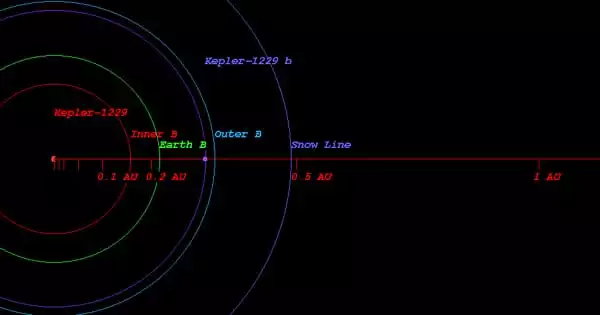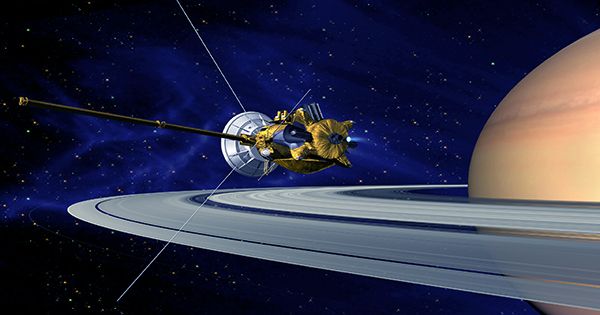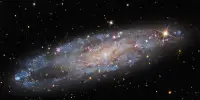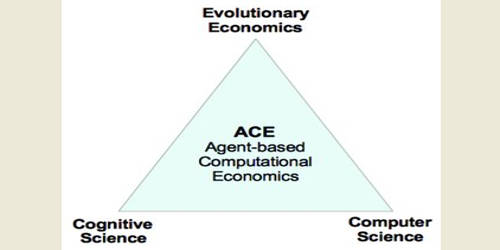Kepler-1229 b is an exoplanet that circles a M-type star. It is most likely rocky and orbits within the habitable zone of the red dwarf Kepler-1229, which is located approximately 870 light-years (267 parsecs) from Earth in the constellation Cygnus. It has a mass of 2.54 Earths, takes 86.8 days to complete one orbit around its star, and is 0.3006 AU away from it.
The Kepler space telescope was discovered it in 2016. The exoplanet was discovered using the transit method, which measures the dimming effect caused by a planet as it passes in front of its star.
Mass, radius, and temperature
Kepler-1229b is most likely a rocky super-Earth, an exoplanet with a larger radius and mass than Earth but less than the gas giants Neptune and Uranus. It has a mass 2.7 times that of the Earth. It has a temperature of 213 K (60 °C; 76 °F) at equilibrium. It is approximately 865.9 light-years (265.5 pc) distant from the Solar System. Its discovery was made public in 2016.
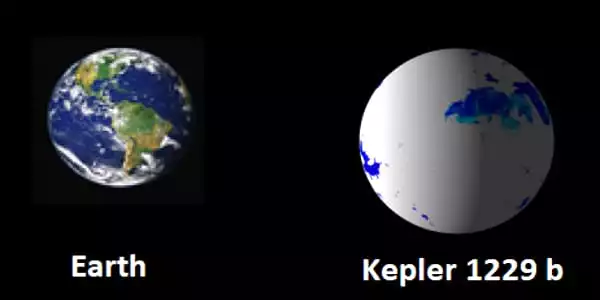
Host star
Kepler-1229b is most likely a rocky super-Earth, an exoplanet with a larger radius and mass than Earth but less than the gas giants Neptune and Uranus. It has a mass 2.7 times that of the Earth. It has a temperature of 213 K (−60 °C; −76 °F). at equilibrium. It is approximately 865.9 light-years (265.5 pc) distant from the Solar System. Its discovery was made public in 2016.
The planet orbits Kepler-1229, a (M-type) star that is orbited by one planet. The star has a radius of 0.51 R☉ and a mass of 0.54 M☉. It is 3.72 billion years old and has a temperature of 3724 K. The Sun, on the other hand, is 4.6 billion years old and has a temperature of 5778 K. The apparent magnitude of the star, or how bright it seems to us from Earth, is 15.474. As a result, it is too dim to see with the naked eye.
Orbit
Kepler-1229b orbits its host star with about 4% of the Sun’s luminosity every 86.829 days at a distance of 0.2896 AU (close to that of Mercury, which orbits at a distance of 0.387 AU).
Habitability
The exoplanet, along with eight others, was discovered to be orbiting in the habitable zone of its parent star, an area where liquid water may exist on the planet’s surface under the right temperatures and atmospheric parameters. Kepler-1229b has a radius of 1.4 REarth, indicating that it is most likely rocky. Its host star is a red dwarf with around half the mass of the Sun. As a result, stars like Kepler-1229 have the potential to survive for 50–60 billion years, or 5–6 times longer than the Sun.
The planet is most likely tidally locked, with one half of its hemisphere always facing the star and the opposite side cloaked in perpetual darkness. However, there would be a sliver of habitability – known as the terminator line – between these two intense zones, where temperatures may be acceptable (approximately 273 K (0 °C; 32 °F) for liquid water to exist. Furthermore, if the planet has a thick enough atmosphere to transport heat to the side facing away from the star, a considerably bigger percentage of it may be habitable.
